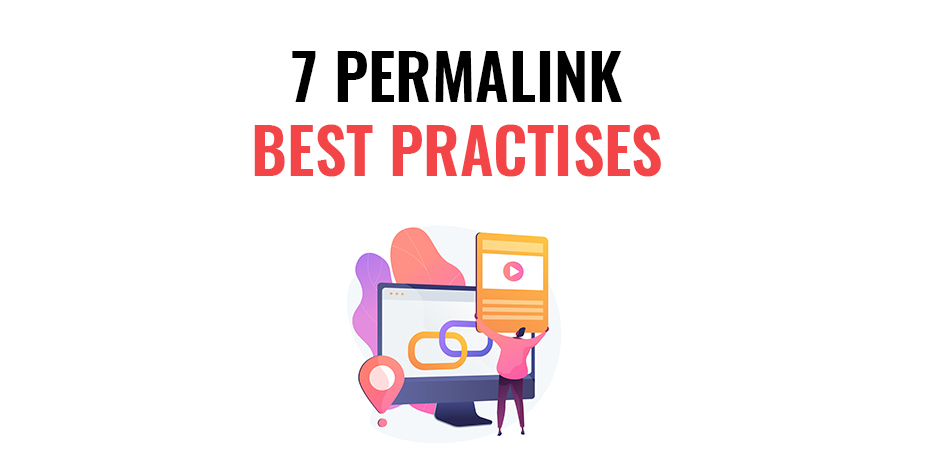
7 permalink best practices
A permalink is a URL for a specific webpage, image or other content that you publish online and by following its best practices, you will improve your SEO and UX. But what are these best practices and how can they improve your website? In this article, we are going to answer that.
Permalink basics.
Before we dive into making the best permalinks for your business website, let’s go over the basics. Every permalink or URL is made up of five parts, but we only need to look at two. The web domain at the beginning and the slug after the first forward slash. Here is an example:
https://www.webdomain.com/slug
Whenever your website’s URL is entered into a browser, it will take the person directly to your website.
Why permalink best practices are important.
There are two big reasons for wanting to get your permalinks correct. We mentioned them before, they are search engine optimisation (SEO) and user experience (UX).
By applying the permalink best practices, search engines link Google will rank you higher. This is not the biggest ranking factor for your website, but it’s an important one especially if you want to gain organic traffic.
A strong URL doesn’t just help Google, but it helps your clients too. A permalink can do this by giving clues to the reader about what is on the page and the path they took to get here. It also allows readers on other websites to understand what to expect when they click on a hyperlink that goes to your website.
We don’t just have to read about it though. Below are two examples of permalinks, one of which is following the best practices. Which one would you rather click on?
- https://www.webdomain.com/index.php?page=546589
- https://www.webdomain.com/best-hotels-cape-town
7 permalink best practices.
If you are creating a new page on your website or are reviewing its UX, run through these 7 permalink best practises to create a strong URL that will boost your performance.
View this post on Instagram
1. Make the URL unique.
No two pages should have the same URL on your website. This will cause several issues that will ruin your client’s browsing experience.
2. Include your SEO keyword research.
Whenever you create a new page on your website, you should be doing keyword research. If you want to know where to begin with that, try our guide: How to do keyword research for your website.
By using the keywords that your webpage is optimised for, you send a strong message to search engines that say your website is the best solution to people’s queries. This will help you rank higher on the search engine results page (SERP).
3. Keep your URLs simple.
Your permalink needs to be simple, relevant to the content and as accurate as possible. Limit the use of unnecessary words and only include dates that are important to the topic. This will make your URL easy to read and understand to people.
4. Be consistent.
Following the previous practice of being easy to read and understand, you need to keep your URLs consistent. They should all follow the same formula that allows users to backtrack or understand exactly where they are just by the URL alone.
5. Separate words with dashes and not underscores.
Never use underscores, spaces or any other character to separate words. You want your URL to be easy to ready and actually work. Spaces break URLs and any other character becomes difficult to read or type. For your websites best interest, only use dashes.
6. Use all lowercase.
Using uppercase characters is an easy way to confuse people and have them land on an error 404 page. People expect URLs to be lower case, so when they type it in that way, you don’t want to rely on their browser to fix that.
7. Don’t get lazy with WordPress.
When creating a new page or post on WordPress, they will often turn the heading into a slug using those exact words. Don’t just settle for this. WordPress did not do the research that you should be doing. If the slug it suggests is not optimal, change it.
Best practices to change a permalink.
While it’s in your best interest to not change a permalink, it’s not always avoidable. There can be many reasons for you to change the URL and it’s very important to get it right if you need to. If not, your website can lose the very important backlinks it gained and severely hurt your SEO.
If you find yourself in the need to change a permalink, you will need to let search engines know where to go and change the path of people using the old link. To do this, you will need to create a 301 redirect. If your website uses WordPress there are fantastic plugins for this. You can also create a .htaccess with the following text in it:
Redirect 301 / http://www.webdomain.com/slug
If the new permalink doesn’t contain ‘www’ in it, you will need to create a different .htaccess file with this text:
Options +FollowSymLinks
RewriteEngine on
RewriteCond %{HTTP_HOST} .
RewriteCond %{HTTP_HOST} !^example.com
RewriteRule (.*) http://webdomain.com/$1 [R=301,L]
Update your website to perform its best with Web2Web.
When it comes time to update your business website, you want it to boost your website’s performance not hurt the SEO that you have worked so hard to get. This includes following the permalink best practises.
When you work with Web2Web to update your website, you get an expert team that will ensure that your website’s online performance will improve with its updates. Don’t wait to rank down on the SERP, talk to us and we can move your website forward in the online world.

 021 551 2060
021 551 2060



